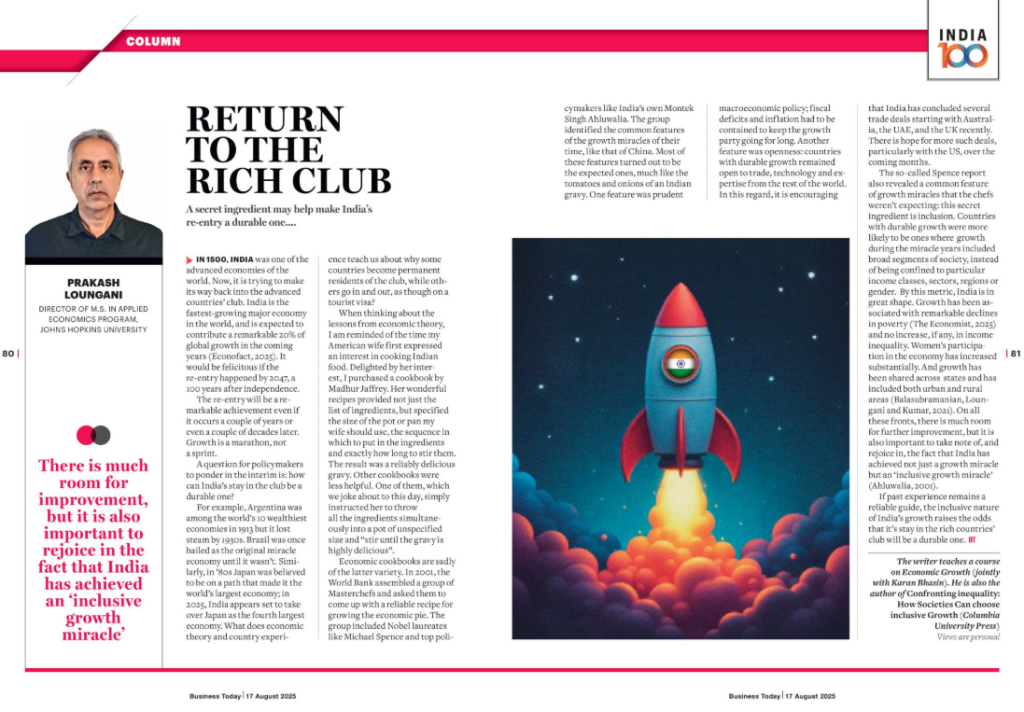Thursday, August 21, 2025
Best of times, worst of times: record fossil-fuel profits, inflation and inequality
From a paper by Gregor Semieniuk, Isabella M. Weber, Iain S. Weaver, Evan Wasner, Benjamin Braun, Philip B. Holden, Pablo Salas, Jean-Francois Mercure, and Neil R. Edwards:
“The 2022 oil and gas crisis resulted in record fossil-fuel profits globally that rehabilitated the oil and gas industry, obstructed the energy transition and contributed to inflation, but their magnitude and beneficiaries have been insufficiently understood. Here we show the size of profits across countries and their distribution across socio-economic groups within the United States, using company income statements, comprehensive ownership data and a network model for propagating profits via shareholdings. We estimate that globally, net income in publicly listed oil and gas companies alone reached US$916 billion in 2022, with the United States the biggest beneficiary with claims on US$301 billion, more than U.S. investments of US$267 billion in the low carbon economy that year. In a network of U.S. shareholdings with 252,433 nodes including privately held U.S. companies, 50 % of profits went to the wealthiest 1 % of individuals, predominantly through direct shareholdings and private company ownership. In contrast the bottom 50 % only received 1 %. The incremental U.S. fossil-fuel profits in 2022 relative to 2021 were enough to increase the disposable income of the wealthiest Americans by several percent and compensate a substantial part of their purchasing power loss from inflation that year, thereby exacerbating inflation inequality. These profits also reinforced existing racial and ethnic inequalities and inequalities between groups with different educational attainments. We discuss how an excess profit tax could be used to both lower inequality and accelerate the energy transition as increasing geopolitical tensions and climate impacts threaten continued volatility in oil and gas markets.”
From a paper by Gregor Semieniuk, Isabella M. Weber, Iain S. Weaver, Evan Wasner, Benjamin Braun, Philip B. Holden, Pablo Salas, Jean-Francois Mercure, and Neil R. Edwards:
“The 2022 oil and gas crisis resulted in record fossil-fuel profits globally that rehabilitated the oil and gas industry, obstructed the energy transition and contributed to inflation, but their magnitude and beneficiaries have been insufficiently understood. Here we show the size of profits across countries and their distribution across socio-economic groups within the United States,
Posted by at 8:16 AM
Labels: Energy & Climate Change
Tuesday, August 12, 2025
Return to the Rich Club: A secret ingredient may help make India’s re-entry a durable one…
This article first appeared in the India@100 special issue of Business Today. Here is a link to the image of the article. The full text is provided below:
In 1500, India was one of the advanced economies of the world. Now, it is trying to make it way back into the advanced countries’ club. India is the fastest-growing major economy in the world, and is expected to contribute a remarkable 20 percent of global growth in the coming years (Econofact, 2025). It would be felicitous if the re-entry happened by 2047, a 100 years after independence.
But re-entry will be a remarkable achievement even if it occurs a couple of years or even a couple of decades later. Growth is a marathon race, not a sprint.
A question for policymakers to ponder in the interim is: how can India’s stay in the club be a durable one? What does economic theory and country experience teach us about why some countries become permanent residents of the club, while others go in and out, as though on a tourist visa?
When thinking about the lessons from economic theory, I am reminded of the time my American wife first expressed an interest in cooking Indian food. Delighted by her interest, I purchased a cookbook by Madhur Jaffrey. Her wonderful recipes provided not just the list of ingredients, but specified the size of the pot or pan my wife should use, the sequence in which to put in the ingredients and exactly how long to stir them. The result was a reliably-delicious gravy. Other cookbooks were less helpful. One of them, which we joke about to this day, simply instructed her to throw all the ingredients simultaneously into a pot of unspecified size and “stir until the gravy is highly delicious”.
Economic cookbooks are sadly of the latter variety. In 2001, the World Bank assembled a group of Masterchefs and asked them to come up with a reliable recipe for growing the economic pie. The group included Nobel laureates like Michael Spence and top policymakers like India’s own Montek Singh Ahluwalia. The group identified the common features of the growth miracles of their time, like that of China. Most of these features turned out to be the expected ones, much like the tomatoes and onions of an Indian gravy. One feature was prudent macroeconomic policy; fiscal deficits and inflation had to be contained to keep the growth party going for long. Another feature was openness: countries with durable growth remained open to trade, technology and expertise from the rest of the world.
But the so-called Spence report also revealed a common feature that the chefs weren’t expecting: this secret ingredient is inclusion. Countries with durable growth were more likely to be ones where growth during the miracle years included broad segments of the society, instead of being confined to particular income classes, sectors, regions or gender. By this metric, India is in great shape. Growth has been associated with remarkable declines in poverty (The Economist, 2025) and no increase, if any, in income inequality. Women’s participation in the economy has increased substantially. and growth has been shared across states and has included both urban and rural areas (Balasubramanian, Loungani and Kumar, 2021). On all these fronts, there is much room for further improvement, but it is also important to take note of, and rejoice in, the fact that India has achieved not just a growth miracle’ but an ‘inclusive growth miracle’ (Ahluwalia, 2001).
If past experience remains a reliable guide, the inclusive nature of India’s growth raises the odds that its’ stay in the rich countries’ club will be a durable one.
The author is the Director of the M.S. in Applied Economics program at Johns Hopkins University, where he teaches a course on Economic Growth (jointly with Karan Bhasin). He is the author of Confronting inequality: How Societies Can choose inclusive Growth (Columbia University Press, 2019).

This article first appeared in the India@100 special issue of Business Today. Here is a link to the image of the article. The full text is provided below:
In 1500, India was one of the advanced economies of the world. Now, it is trying to make it way back into the advanced countries’ club. India is the fastest-growing major economy in the world, and is expected to contribute a remarkable 20 percent of global growth in the coming years (Econofact,
Posted by at 2:52 PM
Labels: Inclusive Growth
Wednesday, August 6, 2025
Okun’s law and digitalization in ASEAN-10 economies
From a paper by Martin Boďa, Mariana Považanová, and Katarína Vitálišová:
“Whilst the economic success of ASEAN countries is frequently attributed to the transformation of their economies towards digitalization and technical innovation, little is known about the unemployment-output behaviour of ASEAN economies in the course of the business cycle. One aspect of this conjunctural behaviour is studied in this chapter in the hope of providing insights into how the unemployment-output relationship–enacted in Okun’s law––unfolds in conjunction with the structural changes of their economies and other factors. A two-stage procedure is applied to that end. First, for a period of three decades, 1991–2022, a time-varying version of Okun’s law is estimated for each ASEAN economy. Second, the estimated Okun coefficients are matched against a set of explanatory variables including various metrics of digitalization, sectoral and labour market characteristics. The results indicate that in the majority of ASEAN economies unemployment was mostly insensitive to output, or that the unemployment-output relationship was constant and otherwise of a negligible magnitude, which corroborates the resilience of economic growth in the Southeast Asian region. Nonetheless, this sensitivity is heightened by the reorientation towards medium and high-tech industries whilst the adoption of digital technologies by the population has actually no effect per se.”
From a paper by Martin Boďa, Mariana Považanová, and Katarína Vitálišová:
“Whilst the economic success of ASEAN countries is frequently attributed to the transformation of their economies towards digitalization and technical innovation, little is known about the unemployment-output behaviour of ASEAN economies in the course of the business cycle. One aspect of this conjunctural behaviour is studied in this chapter in the hope of providing insights into how the unemployment-output relationship–enacted in Okun’s law––unfolds in conjunction with the structural changes of their economies and other factors.
Posted by at 7:48 PM
Labels: Inclusive Growth
Monetary independence and liberalisation of capital flows: an unattainable duo inthe context of financial globalisation and eurozone accession?
From a paper by Klara Perica, Josip Visković, and Mario Pečarić:
“Financial openness affected the reduction and accumulation of reserves, the growth of the degree of monetary policy independence, while the choice of exchange rate regime was not statistically significant. The study thus confirms that monetary policy independence in the era of capital account liberalisation is limited regardless of the type of exchange rate regime.”
From a paper by Klara Perica, Josip Visković, and Mario Pečarić:
“Financial openness affected the reduction and accumulation of reserves, the growth of the degree of monetary policy independence, while the choice of exchange rate regime was not statistically significant. The study thus confirms that monetary policy independence in the era of capital account liberalisation is limited regardless of the type of exchange rate regime.”
Posted by at 7:47 PM
Labels: Inclusive Growth
Monday, August 4, 2025
What can India do to industrialize?
This material first appeared on Noahpinion:
I really believe that Indian industrialization is one of the most important stories in the world today. The fate of over a billion people — most of them still pretty poor — hinges crucially on the question of whether the world’s most populous nation can lift itself out of poverty by its bootstraps, as China has done, and as Vietnam is now in the process of doing.
Instead of writing another post about Indian industrialization, I thought I’d solicit a guest post from Karan Bhasin, who knows a lot about the subject. Karan is a doctoral candidate at University at Albany, SUNY, whose research has documented India’s recent progress in reducing poverty. He’s joined in this post by Prakash Loungani, the Director of the M.S. in Applied Economics program at Johns Hopkins University, who teaches a course on economic growth with Karan. Together, they explain the next steps they think India needs to take in order to supercharge its industrial development.
In February 2023, Noah posed an important question: can India industrialize? The question has been on the minds of Indian economic policymakers since its independence in 1947. Recent attempts at industrializing include Modi Government’s “Make in India” program and the liberal use of industrial policy for sectors such as electronics, semiconductors among others. However, the emphasis on industrial development is not new—India’s second Five-Year Plan in 1956 had already identified rapid industrialization as a key strategy for poverty alleviation.
In the 1950s, India had its own version of the Western Solow growth model—this was the P.C. Mahalanobis growth model, which emphasized the role of investment in capital goods (heavy industry) to drive long-term economic growth. It argued that a country should prioritize investment in industries that produce capital goods (like machinery and equipment) to increase its capacity to produce all types of goods, including consumer goods, in the future. The capital allocation decisions undertaken by India on the basis of the Mahalanobis Model yielded a growth rate of 4.3 percent, encouragingly close to the government’s target of 4.5 percent for 1956-61. This contributed to a growing sense of confidence in the ‘planned approach’ as an effective way to achieve industrialization. The confidence was, however, short-lived as growth started to falter during the Third Five-Year Plan. Indian policymakers started to recognize the need for reforms in their approach, particularly as many East Asian economies had successfully transformed their economies and were rapidly industrializing. These economies had embraced international trade, liberal domestic economy and limited the state to important areas such as rule of law, education and healthcare services etc. To emulate at the success of these “Miracle Economies” – Indian economic policymakers embarked on similar reforms in 1991. The objective behind these reforms was to fundamentally reorient the Indian economy from a planned economy to a market economy, hoping at such reforms would help India rapidly industrialize and move to a higher growth path.
The 1991 reforms were successful in in many respects, but the success came with an Indian accent. Unlike East Asian peers, which first industrialized before pivoting towards services, India achieved success in export of high-value services even as it struggled with exports of labor-intensive products. Figure 1 illustrates that the share of manufacturing in India’s GDP has remained relatively flat, even as the services sector expanded significantly from 40% to 60% between 1980 and 2024. India is, therefore, paradoxically, a large labor-surplus economy which but struggles with labor-intensive production but instead specializes in production of high-value services (and also goods such as pharmaceuticals and more recently electronics).
Continue reading here.
This material first appeared on Noahpinion:
I really believe that Indian industrialization is one of the most important stories in the world today. The fate of over a billion people — most of them still pretty poor — hinges crucially on the question of whether the world’s most populous nation can lift itself out of poverty by its bootstraps, as China has done, and as Vietnam is now in the process of doing.
Posted by at 11:28 AM
Labels: Inclusive Growth
Subscribe to: Posts



